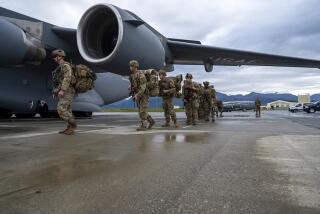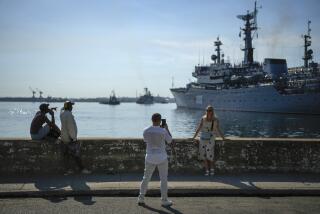Soviets Put In at San Diego in Historic Visit
- Share via
SAN DIEGO — With their crews eager to learn basketball, see American surgery and visit the “fish house,” three Soviet naval vessels sailed into the once-forbidden waters of San Diego Bay--and history--Tuesday, marking the first such military visit to the West Coast in more than a century.
Against the backdrop of the Coronado Bridge and docked U.S. Navy vessels, the two Soviet de stroyers and an oiler pulled into Pier 2 at the 32nd Street Naval Station after exchanging 21-gun nation-to-nation salutes and 17-gun commander-to-commander salutes.
The Soviets were escorted by flocks of smaller pleasure boats, Coast Guard vessels and rubber rafts holding Greenpeace environmentalists, who unfurled banners urging nuclear disarmament in Russian. The Soviet sailors cheered the banners, and the opening ceremonies proceeded with no interruptions.
“The world is changing fast,” Adm. Genadiy Alexandrovich Khatov, commander of the Soviet Pacific Fleet, declared through an interpreter. “If you asked me a year ago if I thought it was possible to come to the United States, the answer would have been negative.”
While top-ranking naval officers from each country expressed lofty ambitions for the unprecedented visit, many of the 850 Soviet sailors had other goals.
“Before we were told that capitalism was bad; now capitalism is good,” said Oleg Ozlov, a 20-year-old petty officer who lives near the Soviet Pacific port of Vladivostok. “I just want to walk around and talk to people.”
For some U.S. and Soviet officers, it was a day they never thought they would live to see. For many, it was an opportunity they never imagined. And, though they had been ashore for just minutes, a few Soviet guests--like Sr. Lt. Dmitri Abramov--already had plans.
Speaking in broken English, the 30-year-old navigator said he wished to go see “fish house.” Seeing the puzzled faces around him, Abramov requested an interpreter, who explained that the young man wanted to visit Sea World, which is included in the busy schedule in the days ahead.
“I want to play basketball,” said Sergei Ushkur, a 21-year-old Russian petty officer from Latvia.
For many, visiting the United States was like a far-fetched fantasy that had almost magically turned into reality.
“When I was a child, America was considered an enemy,” said Dmitri Kuznetsov, a 26-year-old Vladivostok native who is the ship’s doctor aboard the destroyer Admiral Vinogradov. “This was a dream. I want to see how people live. I want to see an operation at a hospital. I don’t want to fight with anybody; I just want to be friends.”
The three Soviet ships--the Admiral Vinogradov, destroyer Boyevoy and support tanker Argun--arrived for an unprecedented five-day visit. It represents the second round of an exchange program established by Adm. William Crowe, former chairman of the U.S. Joint Chiefs of Staff, and Marshal Sergei Akhromeyev, former Soviet chief of staff.
The first round began last July, when Soviet warships paid a port call to the U.S. Navy base in Norfolk, Va. The following month, the U.S. Navy made a visit to Sevastopol in the Black Sea. Next month, the reciprocity will continue as three U.S. ships travel to Vladivostok, home of the Soviet Pacific Fleet.
Adm. Charles Larson, commander of the U.S. Pacific Fleet and host of this week’s visit, said the exchange was designed to foster goodwill.
“We want to exchange ideas and opinions so we can better understand each other,” Larson said.
Officials with various political groups, however, saw the visit as an opportunity to press for political changes.
As the three Soviet ships, led by the Admiral Vinogradov, made their way around the north end of North Island at 8:30 a.m., three rubber boats containing Greenpeace members accompanied them with banners. The boats, which stayed close to the bow of the Admiral Vinogradov, unfurled banners written in Russian. The banners read: “Nuclear navies talk a good game but keep their weapons just the same.”
Soviet sailors cheered when they read the signs, said Lorna Alcorn, a Greenpeace field manager.
After the Soviets’ 9 a.m. arrival, following an 18-day voyage, their vessels hoisted their signal flags amid plumes of gray smoke. White-clad sailors lined the rails as they took in their first glimpse of San Diego. Bright yellow cranes lumbered on the pier as the ships secured their moorings and a Soviet military band played.
Larson and San Diego Mayor Maureen O’Connor welcomed the guests with a version of the traditional Russian khelbsolstvo , the bread-and-salt hospitality ceremony. The American hosts offered pieces of dark rye bread dipped into a shallow dish of salt, as a symbol of sustaining life and offering good taste.
Minutes before Khatov, Larson and O’Connor addressed a small crowd of mostly U.S. Navy officials, the Navy’s Blue Angels aerobatic team flew in diamond formation overhead. After the speeches, the sailors from the Soviet ships were allowed to mingle with those from their American host ships, the guided missile cruiser Leahy, guided missile frigate McClusky and destroyer Merrill.
The scene quickly deteriorated into a frenzy of hugs, photo-takings, and gift exchanges between U.S. and Soviet sailors. Though many U.S. sailors asked their counterparts for their large white, pie-shaped hats adorned with long ribbons, the request was usually turned down. One officer explained that no sailor would be allowed off the ships out of uniform and most had only one hat.
For several hours, sailors and a select group of San Diegans were allowed to board two of the Soviet vessels, where the gift-giving continued. Sailors aboard the U.S. Navy ships offered the Soviet guests red bags containing goodies donated by several sponsors. The bags, adorned with a cookie logo, included a box of Twix cookies, an Aetna Insurance Co. poster of the San Diego skyline, a Blue Angels calendar, a Kiwi shoeshine kit and a bar of Dial soap.
Many civilians, as well as sailors, were filled with awe as they climbed the gangplanks to the Soviet vessels.
“I never expected in my lifetime to board a Soviet ship--this is outstanding,” said Harry Hunt, a San Diego shop owner who visited the Admiral Vinogradov with his 13-year-old daughter, Courtney.
“They are not supposed to be our allies; they are supposed to be our enemies,” said Steve Prairie, a 27-year-old Albuquerque native who joined the Navy two years ago. “And here they are, we are trading information, hats, pins, belts, everything.”
Some had different interests in the visit.
Second Class Petty Officer Dave Tepper, 26, brought a video camera aboard one of the Soviet vessels and said he surreptitiously filmed the bridge navigational and radar systems. Tepper, a sonarman, had trained for years to detect vessels just like the one he had boarded.
“It’s neat to see what we were looking for all these years,” said Tepper, a Chicago resident.
The real eye-opener for the Soviet guests would not be the pomp of the welcome ceremony but the small peek they would have into American life, said Barry A. Zaulauf, a Pentagon senior Soviet analyst.
The Soviet vessels docked at the 32nd Street Naval Station, which “looks just like a Soviet port because it is industrial and has railroad tracks,” Zaulauf said. “But wait ‘til we take them to Balboa Park. Wait ‘til they see the cars and homes. That’s what will impress them the most.”
Navy officials scurried to put the finishing touches on preparations for the Soviets’ visit. A tape was prepared so that, when the sailors visit Sea World later this week, the whale Shamu can lip-sync a welcome message in Russian.
Translators fussed over the address to be given at the Marine Corps Recruit Depot on Thursday. Intending to treat the Soviet guests as though they were actual recruits arriving for training, a drill instructor--using an American interpreter--plans to give the visitors a version of his usual opening pitch.
“I wonder if there is a Russian equivalent of ‘Get your eyes off me, maggot,’ ” one officer mused.
But, after considerable discussion, officials decided that, even if the drill instructor strays and inadvertently curses in his address, the interpreter is not to swear and will keep the patter polite.
MORE STORIES, photos on B1, B3
More to Read
Sign up for Essential California
The most important California stories and recommendations in your inbox every morning.
You may occasionally receive promotional content from the Los Angeles Times.










